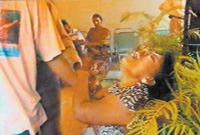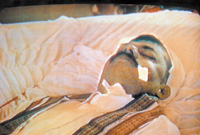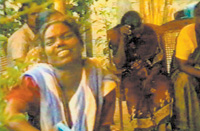 |
|||||||
| |
|||||||
|
Govt. losing control of east
It came in the aftermath of the previous United National Front (UNF) Government's betrayal of the Sri Lanka Army's Directorate of Military Intelligence (DMI) that operated an intelligence cell (or Safe House) at Athurugiriya. Tiger guerrillas unleashed a campaign of violence. Informants and operatives of the Directorate of Military Intelligence were brutally killed or abducted. Violent attacks in the four years that followed a Police raid on the intelligence cell (Safe House) in January 2002, 18 informants, nine operatives, seven "casual informants" and five Police informants - a total of 39 - were killed. Coming under heavy pressure and no support from the then Government, the DMI launched a top secret operation to protect its informants and operatives who escaped the onslaught. Those regarded as "high profile" were found employment abroad. Air tickets were provided for them to make a hasty retreat from Sri Lanka. One such person despatched to a West Asian country was 45-year-old Alagaiah Kirumbarajah. He found employment there as a helper. He was sending money earned from his job for the upkeep of his family. During the December 26 tsunami catastrophe, Kirumbarajah's only daughter, five-year-old Viduja was killed. His wife Koneswari (40) escaped miraculously though her father and mother were also both killed. Their home was destroyed. Saddened by the incident, Kirumbarajah returned to Batticaloa. With no home to live he tried to find shelter in a refugee camp. He was turned away by Tiger guerrillas as an intruder. Without making it known to his friends and relatives, Kirumbarajah moved into the home of his late brother-in-law. The latter was a soldier in the Army and had died in the hands of a suicide bomber in March 2000. Last Monday Kirumbarajah arrived in the Batticaloa town. He was walking along Hindu College road towards the bus station. He was to board a bus to Colombo. At the diplomatic mission of the West Asian country concerned, he was to extend his visa and later leave the country. But guerilla gunmen shot him dead. The incident occurred just 50 metres away from the Batticaloa headquarters Police Station. This incident, one among several in the recent weeks, laid bare a new military campaign unleashed by the Liberation Tigers of Tamil Eelam (LTTE) in the East. If it is a reminder of a replay of events soon after Vinayagamoorthy Muralitharan alias Karuna, LTTE's eastern leader reneged from the Wanni leadership, there was more. The guerrilla targets have now widened from just eliminating or rounding up Karuna loyalists and those who help them. It has taken the form of a stepped up campaign to humble all those who are perceived rivals. On March 6, Dasan, a former member of the Eelam People's Revolutionary Liberation Front (EPRLF) was shot dead in the Batticaloa town. On Friday a grenade was hurled into the office of the People's Liberation Organisation of Tamileelam (PLOTE). Three members of the former guerrilla group and now a political party were injured, two of them critically. This is whilst a manhunt for Karuna loyalists and those helping the security forces goes on unabated. On March 5, three Muslims, two Tamils and a Sinhalese were shot dead by guerrilla gunmen at Kolakanawadiya, a village between Welikande and Manampitiya. They were accused of helping the Karuna faction. Intelligence cadres had spread out in the Batticaloa district to collect information of those who helped the Karuna faction. Police believe this is the reason why guerrilla gunmen abducted four Muslims who were on their way to cultivate their paddy fields in guerrilla controlled areas on March 8. The next day, the body of one farmer was found on the spot from where they were abducted whilst the whereabouts of the others are not known. On March 1, guerrilla cadres attempted to abduct another security forces informant, Johnson Jeyakanthan. He was also one of those who was found safe haven abroad and had returned to the country only a week earlier. After he escaped a kidnap attempt, Army officials say guerrilla supporters lodged a complaint at the Akkaraipattu Police Station accusing him of being involved in a murder. According to the officials, the accusers had also produced "witnesses" to the "murder" in a bid to help frame charges against him. Police say they are investigating the matter further but declined to discuss details. On March 7, Sivarasa Ravindran, an Army informant of Kudapokuna, Welikande was abducted by guerrilla cadres. He had been held in a place of worship but the youth escaped and later surrendered to a nearby police post. Karuna loyalists, though their numbers had dwindled, are offering resistance. Finding sanctuary sometimes in "cleared" or security forces-controlled areas; they have been successful in striking Tiger guerrilla targets. On Friday, their gunmen shot dead two Tiger guerrilla cadres in Vadamunai, Welikande south. Though not with the same vigour since Karuna parted ways a year ago, small but potent groups have been successful in inflicting casualties on the Wanni cadres. Two major events have come as significant turning points for Tiger guerrillas in the east. First was the killing of the LTTE Political Wing leader for Batticaloa and Ampara, Ilayathambi Lingarajah alias Kaushalyan. He was widely regarded as a powerful man in the district whose calls, particularly after the tsumani catastrophe, were promptly heeded by top Government officials in the two districts. He was the highest ranking LTTE member to be killed during the three year long ceasefire. It was a major blow to the LTTE. If the killing on February 7 took place in Punanai, a security forces controlled area, how the incident occurred left open a number of questions. Kaushalyan was returning from Wanni and the Army said he went there without informing them or seeking any security assistance. The LTTE eastern leader had switched vehicles after crossing the Army check-point at Omanthai to continue his journey through "controlled" areas until he reached Batticaloa. The ambush and killing evidently took place with the attackers receiving prior information about his impending arrival. But neither the Police nor the security forces have been able to unravel the mystery over his killing. Both voiced in unison the view that it was the work of members of the Karuna faction but the matter ended there. Behind the scenes, the LTTE leadership in the Wanni were so infuriated they contemplated strong action. This fuelled reports of possible retaliatory attacks on VVIPs or top security forces personnel. At that time, satellite phones in the Wanni went busy with the guerrilla leadership making periodic representations to the Norwegian facilitators in Oslo. It was Special Envoy Erik Solheim's intervention that brought tensions down. He engaged himself in telephone diplomacy, talking to Government officials in Colombo and LTTE leaders in the Wanni. As a result there were no reprisal attacks on Government or security forces targets. In return President Chandrika Bandaranaike Kumaratunga announced the appointment of a Presidential Commission of Inquiry comprising retired members of the judiciary. That was to probe the circumstances under which Kaushalyan met with his death. The appointment of such a Presidential Commission of Inquiry was no doubt a move to appease the LTTE. But its Political Wing leader, S.P. Thamilselvan declared it as an "eye wash." Other than appeasing the LTTE, which is not the case after Mr. Thamilselvan's declaration, serious questions arise over the usefulness of a Presidential Commission of Inquiry. Could such a Commission unearth evidence or information that the regular state agencies tasked with probing a murder could not do? If such agencies have not been able to uncover any evidence or information, they will not be in a position to assist such a Commission. In such an event, the opportunity could be seized by parties and groups opposed to the security forces and the police to make representations against them. On the other hand, it seems highly unlikely that the LTTE that has accused the security forces and paramilitary groups of collaborating in the murder of Kaushalyan would testify before such a Commission. In the first instance, the appointment of a Commission of Inquiry by itself is an admission that the Government is not in full control of its agencies tasked with law, order and security in the East. It is in this backdrop that members of the Karuna faction allegedly attempted to kill three female cadres including Kuveni, the LTTE Women's Wing leader for Batticaloa and Ampara. They were injured seriously and the Government had to provide an Air Force helicopter to airlift them to Colombo. They are now undergoing treatment at the Apollo Hospital. Such helicopter rides are rarely made available to members of the security forces or the police after the ceasefire. The new military campaign by the LTTE has been triggered by the incident involving Kuveni. Yet it has a number of other important connotations too. Though Karuna is no longer in Sri Lanka, he is very much in contact with his core group of loyalists. They are spearheading the attacks to destabilise the LTTE in the East and to deny them a strong foothold. Though they are insignificant in the military balance compared to the LTTE, their attacks have proved more than a nuisance. The fact that they have succeeded in getting away after carrying them out, possibly hiding in security forces controlled areas, has become fuel to the new Tiger guerrilla campaign. The picture becomes more significant if one examines the situation that prevailed before Karuna parted ways. In the East, the LTTE had built up a formidable military and political machine during the ceasefire. Fund raising both locally and abroad benefited the East. An enhanced recruitment drive was carried out. According to intelligence estimates, the LTTE strength in the East that stood at 4,000 before the ceasefire rose to 18,000. But Karuna's exit brought the numbers down to some 12,000, they say. The LTTE also stockpiled arms and ammunition in the East. They conducted extensive training for their cadres and mounted surveillance on high value targets of the security forces. In executing these tasks, the LTTE, for the first time, developed a capability of opening up two fronts against the security forces, one in the North and the other in the East. During the near two decades of separatist war, the strengths of both the LTTE and the security forces have remained depleted as they fought many a battle in the North. This was one of the reasons why the LTTE was unable to dominate large chunks of territory in the East. But Karuna's exit and the resultant internecine warfare within the LTTE have had a devastating effect. Militarily the recruitment campaign in the East has slowed down forcing the guerrilla leadership to pump more cadres from the Wanni. Political activity has slowed down after strained relations with a larger section of the public. Consequently collection of taxes, a major source of income, has proved difficult. In this atmosphere, surprise attacks by the Karuna faction have come as a major stumbling block in their efforts to gain the military and political superiority that existed before Karuna's exit. Embarrassing enough, the LTTE finds it difficult to acknowledge that a breakaway faction has been responsible for all this. Just days after the revolt by Karuna, the LTTE made clear to the Government that the matter was an internal issue and they were capable of solving it. However, thereafter they have continued to accuse the security forces of colluding with paramilitary groups to carry out various attacks. According to an LTTE source, a shift in the position came after their leadership discovered what they called "close connections" between the Karuna faction and sections of the security forces. The LTTE's latest campaign has also extended to wooing the Muslims in the East. Paradoxically such a move came with the assistance of the Government. They made available a helicopter for LTTE Political Wing leader Thamilselvan to fly from Kilinochchi to Batticaloa for Kaushalyan's funeral. He made use of the opportunity to visit Kokkadicholai (Batticaloa district) and Sampur (Trincomalee district) on Februry 14 and 18 respectively for talks with Muslim leaders. These developments explain the widening of LTTE targets in the East from members and helpers of Karuna groups to all others who are perceived to be against. It also includes those who are suspected to be colluding with the security forces. After Kaushalyan's death, at least 14 persons opposed to the LTTE had been killed. Karuna supporters have claimed they killed eight persons who were Wanni loyalists. If the battle for supremacy in the East by the LTTE continues, as they eliminate all rivals, a more disturbing factor has emerged. That is the grim fact that the UPFA Government is fast losing control of the East. It is unable to call a halt to the ongoing violence. Much worse it is not in a position to curb the killings of security forces informants and their operatives. The most it has been able to do is to issue statements or complain to the Sri Lanka Monitoring Mission (SLMM). This is despite most of the present UPFA leaders being the vociferous critics of the previous UNF Government betraying the Army's Directorate of Military Intelligence that ran an intelligence cell (Safe House) in Athurugiriya. Continuing to ignore the East as the law, order and security situation is fast deteriorating can only help the LTTE to establish the same infrastructure that exists in the Wanni. Such an infrastructure, it is widely known now, includes "an army, a police, a sea going arm, the makings of an air force, a judiciary, tax collection machinery and an administrative service." UPFA critics blamed their UNP counterparts for allowing the country's national security to deteriorate. In November 2003, the defence portfolio (together with Interior and Mass Communications) were taken over for these reasons. At last year's parliamentary elections, the UNF Government was voted out of power also largely for the same reasons. And now, the silence in the UPFA hierarchy over these matters is deafening. There have been further developments over last week's exclusive revelations in The Sunday Times (Situation Report) over President Kumaratunga's protest to Norwegian Prime Minister Kjell Magne Bondevik. This was over the LTTE constructing a new airstrip near the Iranamadu tank in Kilinochchi and acquiring air capability. As revealed in these columns, the United States has confirmed to Sri Lanka that one of the light aircraft acquired by the LTTE was a Zlin Z-143 light aircraft manufactured in the Czech Republic. Last Wednesday, Norway's Special envoy Erik Solheim met with LTTE chief negotiator Anton Balasingham in London. No details of this meeting were made public. However, the Colombo based Tamil daily Sudar Oli which reports accurately on the LTTE had the following account last Tuesday: TIGERS ACCEPT PROPOSAL ON COMMON STRUCTURE PUT FORWARD BY NORWAY, AWAITING THE DCISION OF GOVERNMENT SAYS SOLHEIM TO BALA "The LTTE has accepted the proposal put forward by facilitators Norway on setting up a common structure to handle relief and reconstruction work in the aftermath of the tsunami disaster. Norway is awaiting the final agreement of the Sri Lanka government on this proposal. "It is understood that this was announced during a two hour meeting between the LTTE theoretician Anton Balasingham and Norway's special envoy Eric Solheim in London yesterday. "Special envoy Solheim and the Executive Officer at the Norwegian Foreign Ministry Madam Solfred Lien met theoretician Balasingham and his wife Adele at their residence in London. "Solheim briefed Balasingham on the constructive talks held between the Peace Secretariat of the Sri Lankan Government and the LTTE with Norwegian facilitation on the subject of setting up a common structure on post-tsunami reconstruction. "The Tigers have accepted the proposal in this regard put forward by Norway and what remains is for the Sri Lanka Government to endorse and convey its final agreement on the proposal. The Government side has mostly signified its approval but it was understood that Balasingham was informed yesterday that the Government leadership was to pacify the constituent parties of the Alliance government. "Balasingham told Sudar Oli last evening that for their part, they have signified their agreement, and the Norwegian Ambassador will meet their Political Wing leader S.P. Thamilselvan who will arrive at Katunayake tonight (Wednesday) and confirm this matter. "Balasingham
said that the common structure ball is now in Madam Chandrika's
court and things depend on how she handles it. "Balasingham is reported to have replied that the old runway in the area had been in existence even before the ceasefire agreement came into operation and no extension has been made There is nothing in it for the Sri Lanka Government or Madam Chandrika to be concerned about.. Certain media have blown it out of proportion wilfully. "Balasingham also said that he was unaware that the Tigers had any new aircraft and promised Solheim that he would convey the concerns of the Sri Lanka government to the Tigers. "The two sides are also reported to have discussed extensively the general political situation and the atmosphere for resumption of the peace efforts." It is clear Mr. Balasingham has cleverly dodged President Kumaratunga's complaint, made through Norway, by saying that the airstrip had existed even before the ceasefire. As for the acquisition of aircraft, he had not denied it. He had said he was unaware. Political Wing leader Thamilselvan also told the Virakesari Tamil daily last week that the airstrip had existed even before the ceasefire. It would be foolish to expect the LTTE to publicly admit it had constructed a new airstrip and acquired light aircraft. The Government has produced evidence, including a determination by United States authorities about the identity of one light aircraft, to Norway. In the light of the LTTE's claims, what the Government's next move remains the biggest question. |
|||||||
Copyright © 2001 Wijeya Newspapers
Ltd. All rights reserved. |
|||||||


